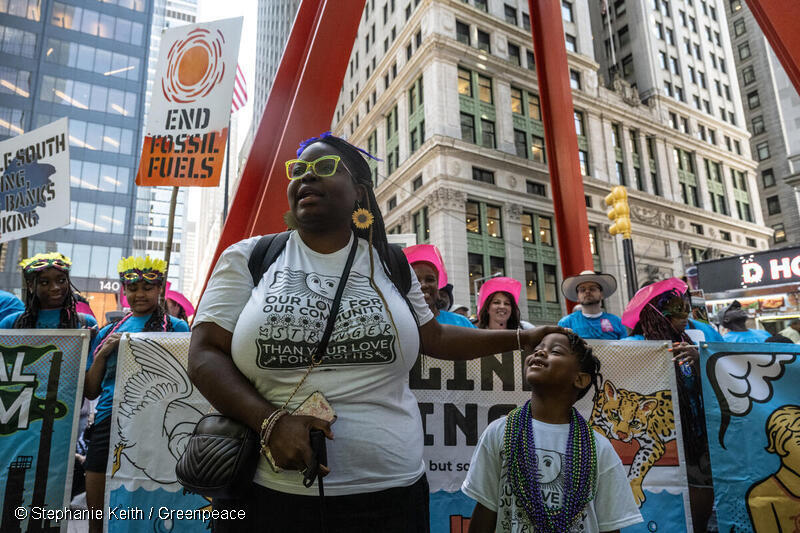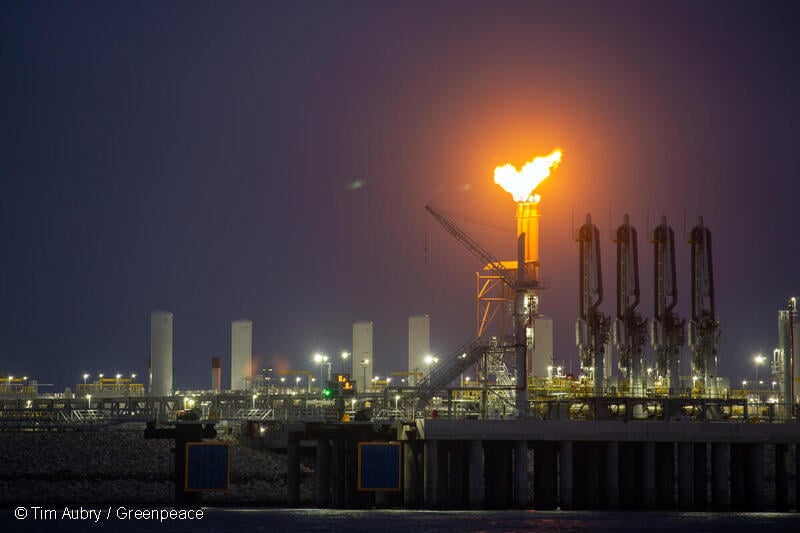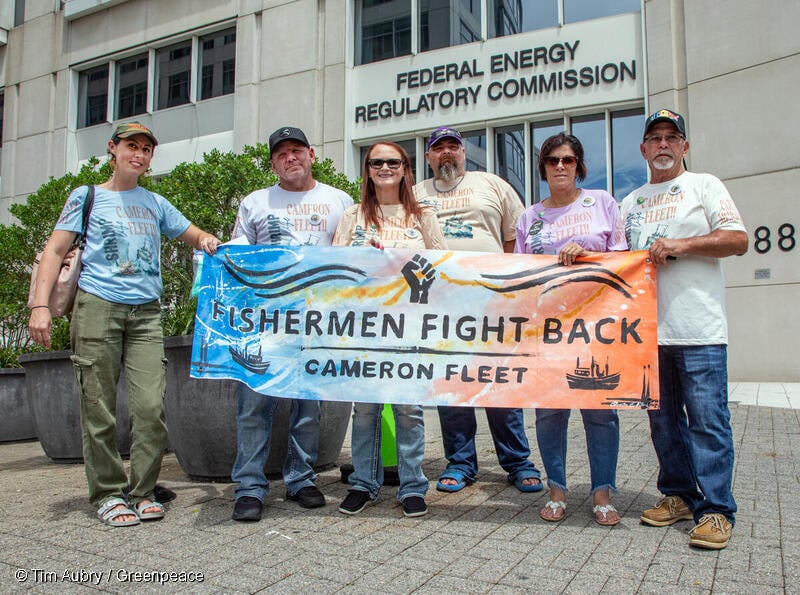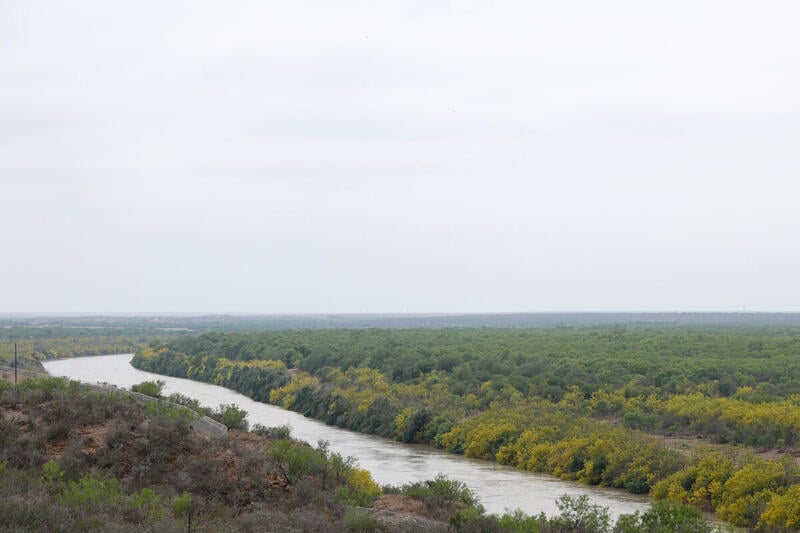How It’s Redefining Our Shores
The Gulf Coast—a critical hotspot for extreme weather events—would benefit the most from a strategic plan designed to phase out fossil fuels and invest in jobs, communities, and resilience.

This post was researched and written by our Summer Research Intern, Marta Tobar.
Across the US and the world, climate change is causing our weather to become more volatile – making storms more severe, heatwaves more intense, and temperatures more extreme. As these extreme weather events become more frequent and severe, coastal communities and their infrastructure become increasingly vulnerable. The United States’ Gulf Coast is especially at risk from higher temperatures, rising sea levels, and more intense hurricanes, highlighting the urgent need for measures to make the region more resilient to climate change. The region is also ground zero for the ongoing boom in liquefied natural gas (LNG) production, exacerbating both climate change and its impacts on nearby communities. With fossil fueled-driven climate change also makes weather events even harder to predict, they become potentially more dangerous for the people in their path.
Rising Temperatures
Scientists found that from July 2023 to June 2024, temperatures reached record highs, with the Earth being 1.64°C hotter than pre-industrial times. June 2024 was the hottest June ever recorded and marked 12 consecutive months with temperatures 1.5°C above the 1850-1900 average. Global temperatures have risen above pre-industrial levels and are on track to reach approximately 5.4°F (3°C) of warming by 2100 if current trends continue. Under this “business as usual” scenario, the National Climate Assessment warns that we will see a lot more severe weather caused by rising temperatures. This will have serious effects on communities, hitting the most vulnerable people the hardest and making existing systemic problems even worse.
The Gulf Coast is experiencing a significant warming trend, with data showing record-high temperatures in recent years. According to the National Oceanic and Atmospheric Administration (NOAA), the region has seen an average temperature increase of about 2.23°F (1.24°C) over the past three decades with some areas experiencing even higher spikes. These rising temperatures are not just statistics; they have alarming implications for both the environment and the communities living in this region. For instance, Louisiana experienced its hottest summer on record in August 2023, resulting in the deaths of 25 people due to heat-related causes. Climate change is making these record-breaking temperatures more likely, putting many lives at risk and causing widespread suffering.
Higher temperatures also contribute to the intensity and frequency of extreme weather events. Warmer air holds more moisture, leading to heavier rainfall and more severe storms. For the Gulf Coast, these changes mean a higher likelihood of devastating hurricanes, heatwaves, and other extreme weather events that can disrupt daily life and essential facilities. Phasing out fossil fuel production to mitigate the impacts of rising temperatures is essential for safeguarding the Gulf Coast against the growing risks of extreme weather and ensuring the region’s long-term resilience.
Sea Level Rise and Coastal Vulnerability
Sea level rise is another pressing issue for the Gulf Coast, particularly in Texas and Louisiana. The sea level in these regions is rising by 5 to 10 mm yearly, much quicker than the global average of 1.7 mm annually. This above average increase is due to a combination of factors, including land sinking – known as land subsidence – alongside other global factors such as polar ice melting.
Looking ahead, the projections are alarming. Over the next 30 years (2020-2050), sea levels along the continuous U.S. coasts are expected to rise by about 11 inches (28 cm). Scientists predict that sea levels could rise by as much as 2.5 to 7 feet by 2100, depending on future greenhouse gas emissions. This would have catastrophic effects on the Gulf Coast, making it more susceptible to flooding, storm surges, and erosion. Coastal communities, especially those in low-lying areas, are facing imminent threats of displacement as sea levels rise and storms intensify, posing a serious risk to their homes, livelihoods, and way of life. Energy infrastructure located along the water edge, such as LNG facilities, is particularly vulnerable, creating potential disaster for nearby communities.
Frequent and Intense Hurricanes
Since the 1970s, warming ocean waters have led to stronger, longer-lasting storms that reach farther inland and bring higher storm surges and devastation. In the 1980s, billion-dollar weather and climate disasters in the U.S. occurred every four months – by the 2010s, they happened every three weeks or less. In 2022, there were 18 such events, resulting in at least $182.4 billion in costs to the U.S. economy and contributing to the deaths of 474 people.
The Gulf Coast has already felt the impact of several devastating hurricanes, including Katrina (2005), Andrew (1992), Rita (2005), Sally (2020) and Laura (2020). These storms have caused widespread destruction, loss of life, and significant economic damage. Hurricane Laura, a Category 4 storm from the 2020 season, struck Cameron Parish in southwestern Louisiana with winds up to 150 mph and storm surges exceeding 15 feet, causing significant damage along the coast and inland. Hurricane Laura had a severe impact on Black and low-income communities that were already facing health and economic hardships from years of industrial development. The storm caused 28 deaths in Louisiana, $12 billion in economic damages, and extensive destruction to water systems and the electrical grid, slowing down recovery efforts. The storm also affected neighboring states, including Texas, Mississippi, and Arkansas, resulting in a total cost of $20.3 billion in damages.
The number of intensifying weather-related disasters along U.S. coastlines is increasing, putting coastal communities at risk of deadly flooding from rising sea levels. Between 2000 and 2021, 38 tropical cyclones caused over $1 trillion in damages (adjusted for 2022 inflation) and resulted in 6,200 deaths. The Atlantic hurricane season is expected to become more active, with projections indicating increased hurricane intensity.
Impacts on LNG Facilities: Expansion and Vulnerability
The Gulf Coast has seen a significant expansion of toxic LNG terminals in recent years. These facilities are particularly vulnerable to hurricanes and extreme weather events. They also contribute significantly to climate change by adding more greenhouse gas emissions to the atmosphere, worsening the already severe impact on the communities living near these industrial sites. LNG facilities regularly emit pollutants even when operating by the book, exacerbating existing health disparities and underscoring the need for stricter environmental regulations and accountability.
Hurricanes can increase operational disruptions at these facilities, which in turn lead to massive releases of emissions and pollutants during shutdowns. These emissions pose environmental and public health risks, particularly for vulnerable communities already facing disproportionate impacts from industrial pollution.

Flaring in March 2023, from the Venture Global Calcasieu Facility is visible for miles in the night sky.
Credit line: © Tim Aubry / Greenpeace
In 2020, Hurricane Laura caused major disruptions at several Gulf Coast LNG facilities, highlighting their susceptibility to severe weather. For instance, Cameron LNG lost power for over a month, causing concern among local residents who witnessed large flares they said “resembled fireballs” in the sky. Operations resumed briefly in October 2020 before Hurricane Delta struck, forcing another shutdown. Hurricane Laura resulted in unplanned releases at the Sabine Pass LNG facility, including 51.5 tons of methane, 7.5 tons of nitrogen oxide, and 64.4 tons of carbon monoxide – way above the facility’s normal limits. These excessive emissions greatly worsen air quality and pose serious health risks for people living nearby.

Protests at a FERC meeting on CP2 June 27, 2024. Embers go FISH with a banner outside the FERC building.
Credit line: © Tim Aubry / Greenpeace
Louisiana community members, including activists from the Vessel Project and FISH (Fishermen Involved in Sustaining Our Heritage) have spoken out about serious problems due to LNG operations. Fishermen are finding it hard to make a living because of increased ship traffic; dredging is reducing both fish and shrimp populations, as well as limiting access to fishing areas. Additionally, LNG companies have closed many boat launches, leaving fishermen with inadequate docking facilities and disrupting their community that has relied on these waters for generations.
Biden’s Halt on New LNG Projects
In January President Biden announced a halt on new LNG project approvals pending a climate and economic impact analysis from the Department of Energy. Biden’s announcement stopped the Department of Energy from approving 17 new LNG projects and opens the door to potentially enforce stricter regulations, but it does not impact existing or already permitted terminals.
Unfortunately, on July 1st, a federal judge in Louisiana overturned the Biden administration’s pause on issuing permits for LNG export terminals. This ruling, celebrated by the fossil fuel industry, does not immediately greenlight any LNG projects but reinstates the review process that was halted.
The Way Forward
The Gulf Coast’s battles against climate change are redefining our shores and challenging us to rethink how we produce energy and protect the environment. LNG production is having a huge impact on the people living in the area, showing us that we urgently need to phase out fossil fuels. Rising temperatures, sea level rise, intensified hurricanes, disruption and expansion of LNG facilities pose significant threats to the region, particularly to coastal communities.
But there is hope for positive change. By signing the petition to make the LNG pause permanent, you can join a collective effort to halt further harm to both communities and the planet, and ensure that future projects align with climate resilience goals. Signing the petition today takes the first step towards a cleaner, safer Gulf Coast. Share your commitment with friends and family, and explore local environmental initiatives to make a direct impact.



